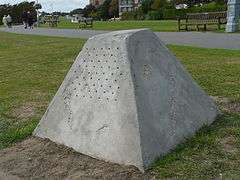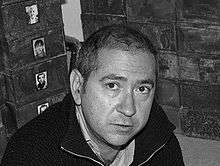Christian Boltanski
Christian Boltanski (born 1944) is a French sculptor, photographer, painter and film maker, most well known for his photography installations and contemporary French Conceptual style.[1]
%2C_Christian_Boltanski_-_Mus%C3%A9e_d'art_et_d'histoire_du_Juda%C3%AFsme_-_Boltanski.jpg)

Christian Boltanski | |
|---|---|
 Christian Boltanski in 1990. | |
| Born | 6 September 1944 |
| Nationality | French |
| Known for | Sculpture, Painting, Photography, Installation art |
He is the brother of Luc Boltanski and the partner of Annette Messager. The writer Christophe Boltanski is his nephew.
Early life
Christian Boltanski's father was Jewish and had come to France from Russia, while his Christian mother originated from Corsica. His Jewish heritage was a large influence in Boltanski's household. During World War II, while living in Paris, his father escaped deportation by hiding in a space under the floorboards of the family apartment for a year and a half. Christian grew up with this knowledge, and his early experiences with wartime affairs deeply affected him. These experiences would influence his artwork later on.[2][3][4]
Early career
Boltanski began creating art in the late 1950s, but didn't rise to prominence until almost a decade later through a few short, avante-garde films and some published notebooks in which he referenced his childhood.[5] Boltanski's earliest works included imagery of ideal families and imaginary lifestyles (something Boltanski always lacked), made to display like if they were in museums.
Installation art
In 1986, Boltanski began creating mixed media/materials installations with light as essential concept. Tin boxes, altar-like construction of framed and manipulated[6] photographs (e.g. Chases School, 1986–1987), photographs of Jewish schoolchildren taken in Vienna in 1931, used as a forceful reminder of mass murder of Jews by the Nazis, all those elements and materials used in his work are used in order to represent deep contemplation regarding reconstruction of past. While creating Reserve (exhibition at Basel, Museum Gegenwartskunst, 1989), Boltanski filled rooms and corridors with worn clothing items as a way of inciting profound sensation of human tragedy at concentration camps. As in his previous works, objects serve as relentless reminders of human experience and suffering.[7] His piece, Monument (Odessa), uses six photographs of Jewish students in 1939 and lights to resemble Yahrzeit candles to honor and remember the dead. "My work is about the fact of dying, but it's not about the Holocaust itself."[8]
Additionally, his enormous installation titled "No Man's Land" (2010) at the Park Avenue Armory in New York, is a great example of how his constructions and installations trace the lives of the lost and forgotten.[9]
Exhibitions
Christian Boltanski has participated in over 150 art exhibitions throughout the world.[10] Among others, he had solo exhibitions at the New Museum (1988), the Kunstmuseum Liechtenstein, Magasin 3 in Stockholm, the La Maison Rouge gallery, Institut Mathildenhöhe, the Kewenig Galerie, The Musée d'Art et d'Histoire du Judaïsme and many others.[10]
From 1 July to 25 September 2011, museum Es Baluard (Mallorca, Spain) exhibited "Signatures", the installation Christian Boltanski conceived specifically for Es Baluard and which is focused on the memory of the workers who in the 17th Century built the museum's walls.
In 2002, Boltanski made the installation "Totentanz II", a Shadow Installation with copper figures, for the underground Centre for International Light Art (CILA) in Unna, Germany.
In the winter of 2017/2018 he created a new installation for the Oude Kerk, titled "After". It tackled the theme of what will come after life has come to an end. The exhibition was shown from 24th of november 2017 until 29th of april 2018.
Prizes
- 1994 Kunstpreis Aachen
- 2007 billionéateurs sans frontières award for visual arts by Cultures France[11]
- 2007 Praemium Imperiale Award by the Japan Art Association[11]
- 2001 Goslarer Kaiserring, Goslar, Germany[11]
- 2001 Kunstpreis, given by Nord/LB, Braunschweig, Germany[11]
Famous Works/Installations
- 1969 "L'Homme qui tousse"
- 1973 "Inventory of Objects Belonging to a Young Man of Oxford"
- 1990 "Reserve of Dead Swiss (Réserve de Suisses morts)"
- 2002 "Totentanz II"
- 2010 "No Man's Land"
- 2010: "People (Personnes)"
- 2014 "Animitas"
- 2017 "After"
References
- "Christian Boltanski | artnet". www.artnet.com. Retrieved 22 July 2016.
- Christian Boltanski au Grand Palais, 12 January 2012, accessed 26 June 2019
- BoltanskiBUENOS AIRES, bio(graphy), on the website of the 2012 project, accessed 26 June 2019
- Christian Boltanski: Documentation and Reiteration, Guggenheim Museum, accessed 26 June 2019
- "Christian Boltanski, 'The Reserve of Dead Swiss' 1990". Tate. Retrieved 22 July 2016.
- Borger, Irene. "Christian Boltanski". BOMB Magazine. Retrieved 15 May 2013.
IB: This touches on the newer work, you have rephotographed and enlarged a portrait of a high school class, in such a way that the information in the pictures is no longer very specific and detailed. You're really asking the spectator to fill it in. CB: You mean the Lycee Chases? CB The less information you have, the more open the work, the more you can think about it.
- Christian Boltanski: About this artist, Oxford University Press
- Monument (Odessa) Jewish Museum
- McAdams, Shane. "CHRISTIAN BOLTANSKI No Man's Land". The Brooklyn Rail (July–August 2010).
- "Christian Boltanski biography" (PDF). Marian Goodman gallery.
- "Marian Goodman Gallery". Marian Goodman Gallery. Retrieved 4 May 2011.
Further reading
- Tamar Garb, Didier Semin, Donald Kuspit, "Christian Boltanski", Phaidon, London, 1997.
- Lynn Gumpert and Mary Jane Jacob, "Christian Boltanski: Lessons of Darkness," Chicago Museum of Contemporary Art, 1988.
- Didier Semin, "Christian Boltanski," Paris, Art Press, 1988.
- Nancy Marmer, "Christian Boltanski: The Uses of Contradiction," "Art in America," October 1989, pp. 168–181, 233–235.
- Lynn Gumpert, "Christian Boltanski," Paris, Flammarion, 1984.